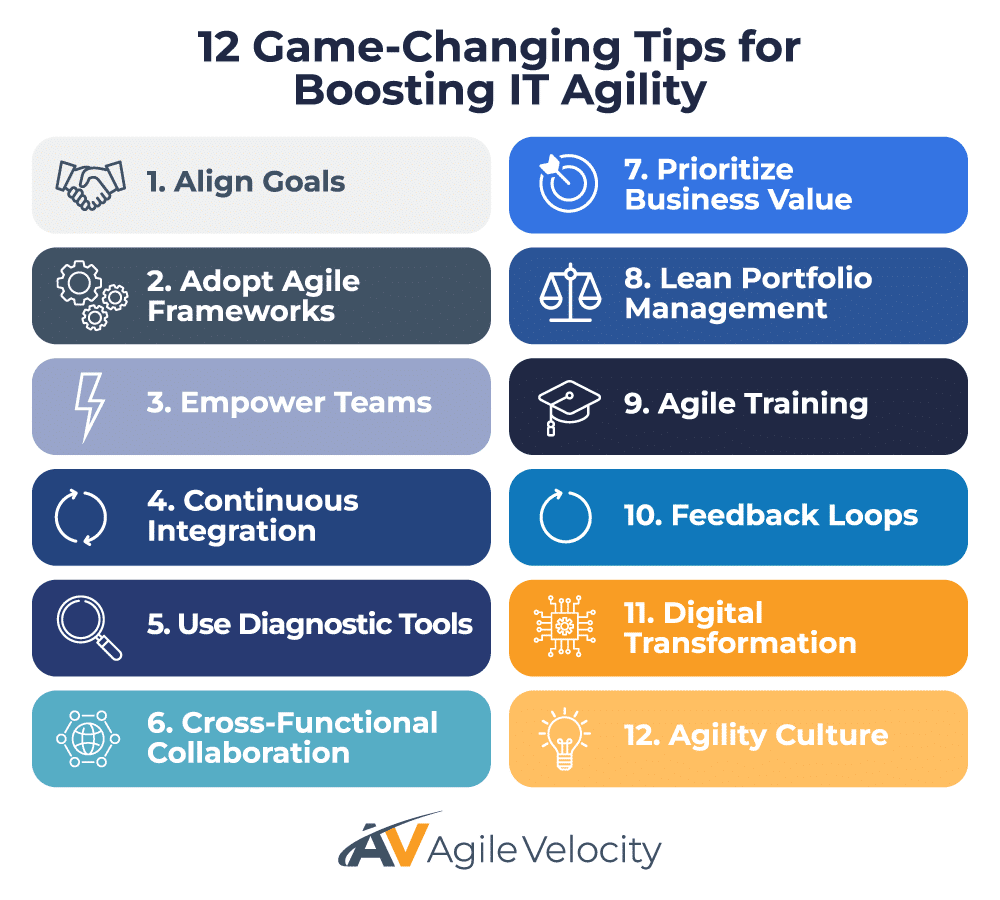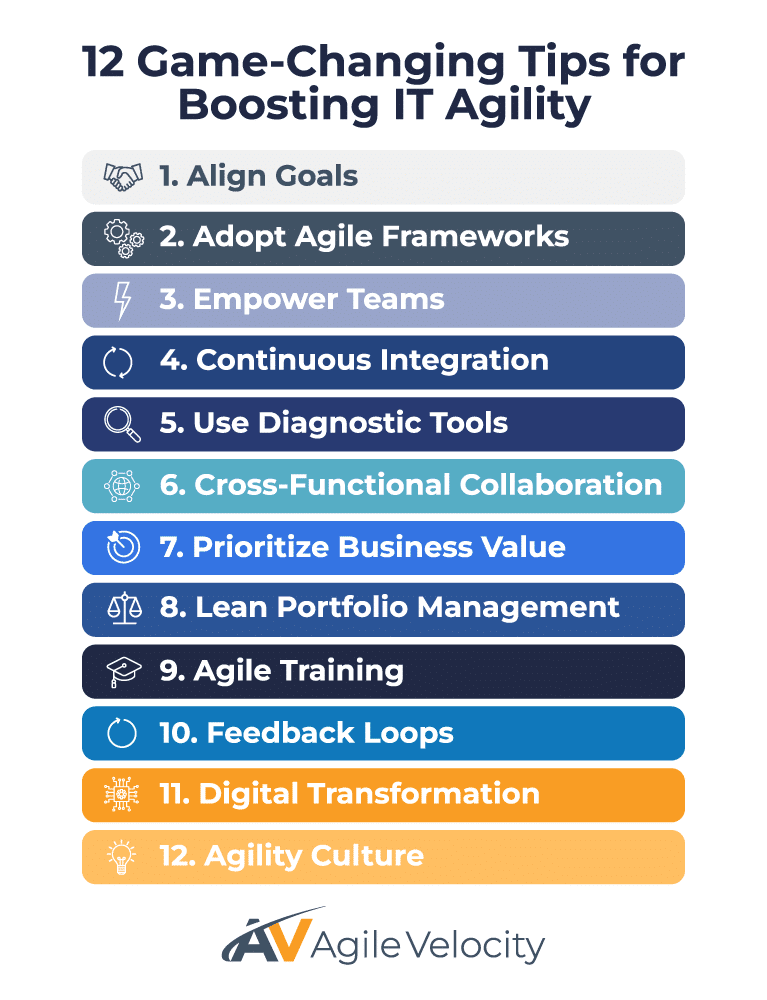IT Agility drives organizations to thrive in a fast-paced digital world. It’s about creating a mindset that allows IT teams to quickly respond to change, deliver meaningful results, and support innovation. When IT Agility is achieved, businesses stay ahead of the competition by driving faster, smarter, and more efficient outcomes.
This article shares 12 practical tips to help your organization strengthen IT Agility. From aligning technology goals with business objectives to empowering teams and streamlining workflows, these actionable strategies guide your teams toward better collaboration, faster decision-making, and sustainable growth.
Tip 1: Align IT Agility Goals with Business Objectives
Effective IT Agility begins when IT initiatives connect clearly with business objectives. Start by engaging key stakeholders from different departments to define what agility means for the organization. Determine whether agility translates into faster feature delivery, improved customer experiences, or more adaptable responses to market shifts.
Set concrete, measurable goals—such as reducing project delivery time by 20% or boosting customer satisfaction scores—to provide clarity and direction. This alignment fuels collaboration, keeps projects focused on delivering value, and drives shared accountability across the organization. By linking IT performance with business impact, organizations can ensure every action is purpose-driven.
Tip 2: Adopt Agile Frameworks to Supercharge IT Teams
Transitioning from traditional methods to Agile frameworks can revolutionize IT operations. Frameworks like Scrum use timeboxes called Sprints to deliver incremental improvements, while Kanban focuses on continuous workflow optimization through visual management and Work In Progress (WIP) limits. Leveraging these techniques helps organizations adapt rapidly as conditions evolve.
For larger organizations, methodologies such as SAFe® can coordinate efforts across multiple teams. These approaches facilitate structured communication and foster an environment of continuous improvement. Additionally, using Agile frameworks helps clarify roles and responsibilities among team members, ensuring that Product Owners, Scrum Masters, and technical staff understand their contributions to the overall cycle.
Tip 3: Empower IT Teams to Make Decisions
Empowering IT teams with decision-making authority eliminates bottlenecks and speeds up responses. Granting team members the autonomy to prioritize tasks and select tools fosters ownership and innovation. When teams are trusted, they develop stronger problem-solving skills and adapt quickly to unforeseen challenges.
Cultivate a culture of trust and accountability by incorporating regular feedback sessions like Sprint Retrospectives, where teams review performance, celebrate successes, and identify areas for improvement. Working with an experienced Agile Coaching partner can further reinforce this empowerment. Confidence and initiative at the team level accelerate the overall transformation process.
Tip 4: Harness the Power of Continuous Integration, Delivery, and Testing
Implementing Continuous Integration (CI), Continuous Delivery (CD), and automated testing creates a resilient and adaptive IT workflow. With CI/CD pipelines, developers merge work frequently and deploy smaller updates, reducing delays and ensuring quality releases. This approach minimizes risk by catching errors early.
Open-source tools can help automate builds, while automated tests—whether unit, integration, or end-to-end—provide rapid feedback. This incremental method delivers continuous value with less risk, significantly boosting your team’s reliability and speed.
Tip 5: Use Diagnostic Tools to Assess Agile Maturity
Achieving IT Agility requires clarity on current performance and identifying areas for improvement. Various diagnostic tools can provide insights into your Agile maturity by examining areas such as backlog prioritization and team dependencies. For example, the Path to Agility® Navigator from Agile Velocity is designed to help organizations assess their Agile journey by tracking progress and identifying actionable improvement areas. This tool is intended to support teams in visualizing key change points and planning subsequent steps to advance their transformation efforts.
By breaking down large changes into manageable actions, diagnostic tools help your teams align on objectives and transition from traditional to Agile practices without undue confusion. This clarity reduces delays and keeps everyone on track.
Tip 6: Foster Cross-Functional Collaboration
IT Agility thrives on breaking down silos. Cross-functional collaboration ensures that IT and other business departments work together to deliver higher-quality results. Practices such as Agile Release Trains coordinate planning across teams and stakeholders, creating shared understanding during Planning Intervals.
Utilize tools such as Kanban Boards or centralized dashboards to provide real-time visibility into project progress. This transparency streamlines communication, minimizes misalignment, and enhances the team’s capacity to respond collectively to challenges.
Tip 7: Prioritize Business Value, Not Outputs
It is important to shift focus from completing tasks to generating real business value. Ask yourself, “What impact does this deliverable have on customers or the bottom line?” Align IT initiatives with measurable business outcomes rather than just tracking completed features.
Techniques such as value mapping help teams prioritize work that drives meaningful results, like increasing user engagement or reducing operational costs. This outcome-driven approach fosters a purpose-oriented team culture, where every action is evaluated for its contribution to long-term success.
Tip 8: Streamline Priorities with Lean Portfolio Management
Lean Portfolio Management ensures that resources are allocated to the most valuable initiatives. This approach offers full visibility of projects through portfolio-level Kanban Boards, allowing leaders to spot misaligned efforts and reassign resources as needed.
By removing bureaucratic barriers and enabling faster decision-making, Lean Portfolio Management connects day-to-day tasks with larger strategic goals. This clarity drives more efficient work cycles and a stronger focus on high-impact projects.
Tip 9: Strengthen IT Agility with Agile Training and Continuous Development
Investing in Agile Training and ongoing team development is essential for sustainable IT Agility. Training helps teams master frameworks like Scrum, Kanban, or SAFe, while coaching provides hands-on guidance during key Agile events such as Sprint Planning and Sprint Reviews.
Ongoing learning opportunities, whether through advanced certifications or internal workshops, ensure that skills remain current in a rapidly evolving landscape. Continuous development empowers teams to innovate and adapt confidently, creating a culture where learning and growth are integral.
Tip 10: Build Feedback Loops to Drive Continuous Learning
Regular feedback loops are vital for maintaining IT Agility. Agile events such as Sprint Reviews, Daily Scrum sessions, and Retrospectives provide opportunities for gathering insights from both stakeholders and team members.
Encourage a culture where feedback is frequent and constructive, enabling swift adjustments in processes and project direction. This ongoing dialogue helps refine practices, clear roadblocks, and continuously align projects with evolving user needs. By making adaptation routine, teams become more proactive in addressing potential challenges.
Tip 11: Maximize IT Agility through Digital Transformation and AI Integration
Modernizing your technology stack is key to bolstering IT Agility. Digital transformation helps replace outdated legacy systems with scalable solutions that accelerate deployments and improve responsiveness.
Integrating Artificial Intelligence (AI) optimizes workflows by automating routine tasks like data logging or performance analysis. AI can also enhance predictive capacity, freeing teams to focus on strategic projects.
Tip 12: Build a Culture of Agility and Adaptability
True IT Agility extends beyond processes—it is a cultural commitment. Leaders set the tone by championing transparency, encouraging experimentation, and rewarding innovative ideas. Dedicated initiatives like Innovation Days or Idea Sprints energize teams and promote creative problem-solving.
Building an environment that values open communication and continuous improvement not only strengthens resilience but also prepares teams to tackle emerging challenges. When agility is part of the daily routine, the organization can adapt swiftly to change and seize new opportunities.
Measuring and Sustaining IT Agility
To ensure these strategies deliver lasting benefits, it is essential to measure and sustain IT Agility over time. Organizations can implement key performance indicators (KPIs) such as shorter cycle times, increased deployment frequencies, or improved team satisfaction scores to gauge progress. Regularly reviewing these metrics allows leaders to identify what is working well and pinpoint areas needing further adjustment.
In addition to quantitative metrics, qualitative feedback from team members and stakeholders is an invaluable source of insight. This continuous assessment helps in refining processes and sustaining the momentum of Agile practices. By embedding regular evaluation cycles into routine operations, companies can anticipate potential challenges and innovate preemptively.
Embrace IT Agility for Continuous Innovation and Competitive Advantage

Achieving IT Agility requires aligning people, processes, and tools to build a responsive, value-driven organization. By connecting IT goals with business objectives, embracing Agile frameworks, empowering teams, and streamlining workflows, your company can build an adaptable framework that thrives in a dynamic environment. Practices such as Lean Portfolio Management, continuous feedback loops, and ongoing development ensure sustainable progress, while diagnostic tools like Path to Agility® Navigator provide insights to drive improvement.
IT Agility isn’t just about transforming processes—it’s about embedding agility into the organizational culture. Whether you are scaling collaboration, modernizing systems, or optimizing workflows, these 12 tips will help your teams deliver meaningful results.
If you’re ready to take your journey further, Agile Velocity is here to help. With expertise in Agile Transformation, SAFe, Lean Portfolio Management, Agile Coaching, and more, Agile Velocity partners with organizations to accelerate value delivery and create self-sustaining teams. Contact Agile Velocity to discover how your organization can navigate change, achieve agility at scale, and deliver exceptional results.





